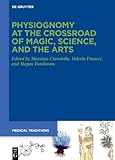Physiognomy at the Crossroad of Magic, Science, and the Arts / ed. by Massimo Ciavolella, Valeria Finucci, Megan Tomlinson.
Material type: TextSeries: Medical Traditions ; 11Publisher: Berlin ; Boston : De Gruyter, [2024]Copyright date: 2024Description: 1 online resource (XVI, 332 p.)Content type:
TextSeries: Medical Traditions ; 11Publisher: Berlin ; Boston : De Gruyter, [2024]Copyright date: 2024Description: 1 online resource (XVI, 332 p.)Content type: - 9783111212746
- 9783111240732
- 9783111240671
- 138 23/eng/20241002
- BF851 .P59 2024
- online - DeGruyter
- Issued also in print.
| Item type | Current library | Call number | URL | Status | Notes | Barcode | |
|---|---|---|---|---|---|---|---|
 eBook
eBook
|
Biblioteca "Angelicum" Pont. Univ. S.Tommaso d'Aquino Nuvola online | online - DeGruyter (Browse shelf(Opens below)) | Online access | Not for loan (Accesso limitato) | Accesso per gli utenti autorizzati / Access for authorized users | (dgr)9783111240671 |
Frontmatter -- Acknowledgments -- Contents -- List of Figures -- List of Contributors -- Introduction -- Revealing and Concealing: Physiognomy and Bodily Signs -- Facial Signs -- Physiognomy: The Origins -- Between the Face and the Skull: Jacopo Ligozzi and the Other Side of the Mirror -- Profiling Deviance, Embodying Passions: Facing and Effacing Character Norms in 19th-century Europe -- Angelica, Clorinda and the descriptio puellae -- Transforming Faces -- Facial Gender-Affirming Surgery: Shaping Physiognomy for Transgender and Gender Non-Congruent Individuals -- Fugitives, Physiognomy, Surgery, and Face Recognition Technology in the Modern Surveillance State -- Modifying One’s Physiognomy in Antiquity -- Faces in Rocks and Trenches: Facial Framings and Post-Colonial Dilemmas in the Australian Cinema of Peter Weir -- Deciphering Faces -- Reading Body Language and Physiognomic Signs in Andrea Mantegna’s Painting The Triumph of Virtue -- The Cult of Beauty and Wellbeing in the Humana Physiognomonia and Other Works by Giovan Battista della Porta -- The French Lavater: Translating Physiognomy into Science in the Late Enlightenment and Beyond -- The Language of Emotions: From the Physiognomy of Giovan Battista della Porta to the Neuroscience -- Folk Psychology and Physiognomy: Competing Strategies for Reading Other Minds -- Index
restricted access online access with authorization star
http://purl.org/coar/access_right/c_16ec
The essays examine how the study of facial features or expressions as indicative of character or ethnicity, has evolved from the crossroad of magic, religion and primitive medicine to present-day cultural concern for wellness and beauty. In this context, the discoveries of cranio-facial neurophysiology and psychology and the practice of cosmetic and reconstructive surgery have a centuries-old relationship with physiognomy. As the study of outward appearances evolved from its classical roots and self-representations through 18th- and 19th-century adaptations in fiction and travelogues, it gradually became a scientific discipline. Along the way, physiognomy was associated with phrenology and craniology and promoted eugenic policies. Tainted with racial bigotry and biological determinism, it was trapped within questions of delinquency, monstrosity and posthumanism. Throughout its history, physiognomy played both positive and negative roles in the evolution of significant aspects of the socio-cultural order in the West that merit update and in-depth study. The contributions follow a chronological and intertwining sequence to encompass physiognomic expressions in art, literature, spirituality, science, philosophy and cultural studies.
Issued also in print.
Mode of access: Internet via World Wide Web.
In English.
Description based on online resource; title from PDF title page (publisher's Web site, viewed 20. Nov 2024)


